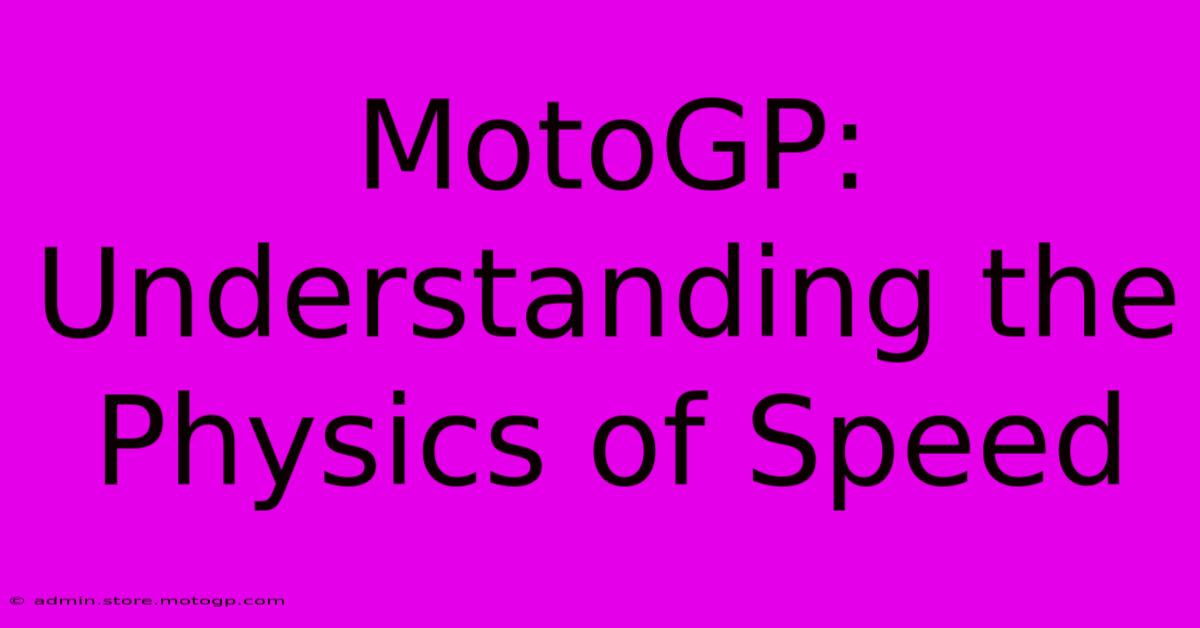MotoGP: Understanding The Physics Of Speed

Table of Contents
MotoGP: Understanding the Physics of Speed
MotoGP, the pinnacle of motorcycle racing, is a breathtaking spectacle of speed, skill, and precision. But beyond the roar of the engines and the blur of motion lies a fascinating world of physics that governs every aspect of the race. Understanding these principles helps appreciate the incredible feats of these riders and their machines.
The Physics of Acceleration and Braking
The heart-stopping accelerations and seemingly impossible braking maneuvers in MotoGP are governed by fundamental physics principles:
Newton's Laws of Motion:
- Newton's First Law (Inertia): A body in motion stays in motion unless acted upon by an external force. This explains why riders lean into corners – resisting the centrifugal force that would otherwise throw them off their bikes.
- Newton's Second Law (F=ma): Force equals mass times acceleration. The powerful MotoGP engines generate immense force, accelerating the lightweight bikes to incredible speeds. The rider's skill in applying this force effectively, especially during corner entry and exit, is crucial.
- Newton's Third Law (Action-Reaction): For every action, there's an equal and opposite reaction. This is evident in braking, where the force applied to the brakes creates a reaction force that slows the bike down. The effectiveness of this braking depends on tire grip and the rider's skill in modulating the brakes.
Friction and Grip:
Tire grip is paramount in MotoGP. The interaction between the tire's rubber and the track surface generates the friction needed for acceleration, braking, and cornering. Factors influencing grip include:
- Tire Compound: Different tire compounds are used depending on track temperature and conditions. Softer compounds provide more grip but wear out faster.
- Track Surface: The condition and type of track surface significantly impacts grip. A smooth, clean track offers superior grip compared to a dirty or wet one.
- Aerodynamics: The aerodynamic design of the bike influences downforce, pushing the tires firmly onto the track, enhancing grip.
Cornering Dynamics: Leaning into the Limit
Cornering in MotoGP is a complex interplay of forces:
Centrifugal Force:
As a bike navigates a corner, centrifugal force pushes it outwards. Riders counter this by leaning the bike and their bodies into the turn, transferring their weight and using the tires' grip to maintain control.
Centripetal Force:
This force, acting towards the center of the turn, is generated by the friction between the tires and the track surface. The bike's lean angle and speed determine the magnitude of this force.
Angle of Attack:
The angle between the bike's lean angle and the direction of travel is critical. Finding the optimal angle of attack maximizes grip and allows for the fastest corner speeds.
Aerodynamics: The Unsung Hero
Aerodynamics plays a crucial role in MotoGP, influencing both speed and stability:
Downforce:
Wings and other aerodynamic elements generate downforce, pressing the bike onto the track, improving stability and grip, particularly at high speeds.
Drag:
Drag is the resistance the bike experiences as it moves through the air. Minimizing drag is essential for achieving maximum speed on straights. Teams constantly refine bike designs to reduce drag while maintaining sufficient downforce.
The Rider's Role: The Human Factor
While physics governs the mechanics, the rider's skill and judgment are paramount. Their ability to manage these forces, anticipate changes in track conditions, and make split-second decisions separates the champions from the rest.
In Conclusion:
MotoGP is a thrilling display of cutting-edge technology and human skill, all underpinned by fundamental physics. Understanding these principles allows for a deeper appreciation of the incredible speeds, breathtaking maneuvers, and the intense competition at the heart of this captivating sport. The constant push for greater speed and efficiency in MotoGP continues to push the boundaries of physics and engineering, making it a fascinating area of study for both enthusiasts and scientists alike.

Thank you for visiting our website wich cover about MotoGP: Understanding The Physics Of Speed. We hope the information provided has been useful to you. Feel free to contact us if you have any questions or need further assistance. See you next time and dont miss to bookmark.
Featured Posts
-
Moto Gp Sprintrennen Witness The Drama Unfold
Feb 19, 2025
-
Lub Si Cota For Busy People Quick And Easy Tips
Feb 19, 2025
-
Moto 3 Bikes Experience The Thrill Of Moto 3 Racing
Feb 19, 2025
-
Motorcycle Safety Gear Avoid Counterfeit Products
Feb 19, 2025
-
Explore The Wonders Of The Queen Circuit
Feb 19, 2025
